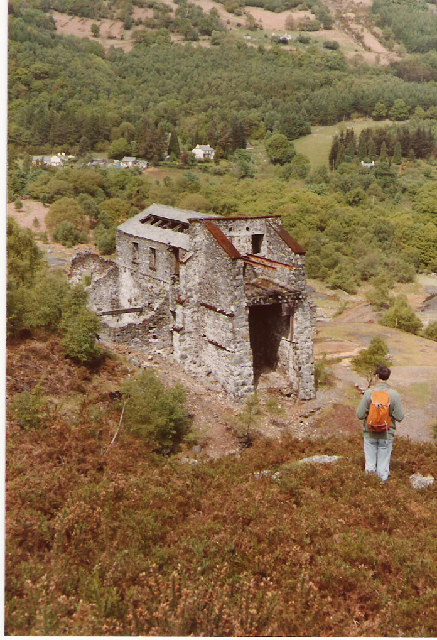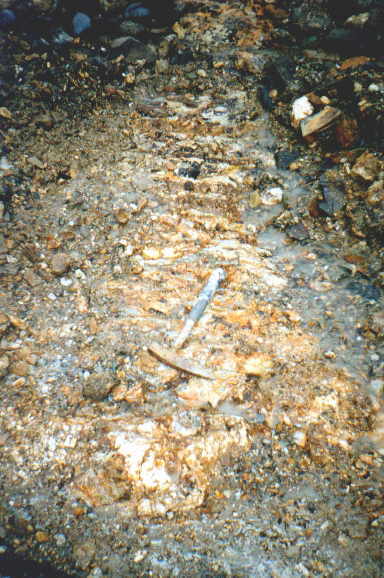|
Klondyke Mill
Klondyke Mill was an ore processing mill on the edge of the Gwydir Forest, near Trefriw, north Wales. Constructed in 1900, the mill was built to receive lead ore (and some zinc ore) from Pandora mine, some 2 miles away – with which its history is inextricably linked – this ore travelling along a tramway which followed the eastern shore of Llyn Geirionydd. The mill saw little usage; Pandora mine was never profitable after construction of the mill, and the mine ceased operation in 1905. Klondyke mill itself closed in 1911 after having a short succession of optimistic owners. In the 1920s, the mill achieved notoriety as the scene of an elaborate money-making scam, when investors were sought for the Klondyke mine, which was allegedly rich in silver. It is this scam which gives the mill its current name; during its years of operation it was initially known as Geirionydd Mill, then as the New Pandora Lead Works. Today the mill lies in a ruined state, a tribute to the false opt ... [...More Info...] [...Related Items...] OR: [Wikipedia] [Google] [Baidu] |
Klondyke Lead Mine - Geograph
Klondyke may refer to: Places *Klondyke, Ontario, Canada *The Klondyke, a causeway connecting Coley's Point and Bay Roberts#The Klondyke Causeway, Bay Roberts, Newfoundland and Labrador, Canada *the former name for Hazelridge, Manitoba, Canada *an area south of Vang, Bornholm, Denmark *Klondyke Pit, the colloquial name for the former Newcraighall Colliery in Edinburgh, Scotland *Klondyke mill and mine, near Trefriw in north Wales United States *Klondyke, Arizona **Klondyke School District *Klondyke, Indiana *Klondyke, Parke County, Indiana *Klondyke, Louisiana, the north end of Louisiana Highway 55 *Klondyke, Minnesota *a neighbourhood of Asheville, North Carolina *the former spelling for Klondike, Dawson County, Texas People * Klondyke Kate (born c. 1962), English professional wrestler * Klondyke Raaff (1879–1949), South African international rugby union player *a ring name for Sirelda, a Canadian professional wrestler Other uses *a nickname used for GNR Class C1 (small boile ... [...More Info...] [...Related Items...] OR: [Wikipedia] [Google] [Baidu] |
Kerr, Stuart And Company
Kerr, Stuart and Company Ltd was a locomotive manufacturer in Stoke-on-Trent, England. History It was founded in 1881 by James Kerr as "James Kerr & Company", and became "Kerr, Stuart & Company" from 1883 when John Stuart was taken on as a partner. The business started in Glasgow, Scotland, but during this time they were only acting as agents ordering locomotives from established manufacturers, among them Falcon, John Fowler & Co. and Hartley, Arnoux and Fanning. They bought the last-named company in 1892 and moved into the California Works in Stoke to begin building all their own locomotives. Hartley, Arnoux and Fanning had also been building railway and tramway plant. This side of their business was sold to Dick, Kerr and Co. in Preston. Notable Kerr, Stuart employees * R. J. Mitchell, Premium Apprentice, later to design the Supermarine Spitfire aircraft. * L. T. C. Rolt, Premium Apprentice, later to be an author and canal/railway preservation pioneer. * T. C. B. Colem ... [...More Info...] [...Related Items...] OR: [Wikipedia] [Google] [Baidu] |
Buddle Pit
A buddle pit or buddle pond is a pit, often circular when specifically constructed, the purpose of which was to separate by sedimentation minerals from lighter rock dust in crushed ore, and used in the mineral mining industry (such as in extracting tin, lead and zinc). Many of the relics seen today date from Victorian times. Early examples of buddle pits were often natural hollows in the ground, adapted by lining them with stone or clay to make them waterproof. A purpose-built pit, constructed from stone or brick, cement and mortar, contained water, and a set of brushes, often powered by a water wheel, which rotated in the water in order to agitate the mixture, the result of which was that the heavier and denser material - i.e. the ore - tended to collect at the centre of the pit, from where it could be retrieved. The worthless gangue was then disposed of, often by draining. Usually a set of buddle pits was utilised, with the richer central deposits in the pit being carried ... [...More Info...] [...Related Items...] OR: [Wikipedia] [Google] [Baidu] |
Scotland Yard
Scotland Yard (officially New Scotland Yard) is the headquarters of the Metropolitan Police, the territorial police force responsible for policing Greater London's 32 boroughs, but not the City of London, the square mile that forms London's historic and primary financial centre. Its name derives from the location of the original Metropolitan Police headquarters at 4 Whitehall Place, which also had an entrance on a street called Great Scotland Yard. The Scotland Yard entrance became the public entrance, and over time "Scotland Yard" has come to be used not only as the name of the headquarters building, but also as a metonym for both the Metropolitan Police Service itself and police officers, especially detectives, who serve in it. ''The New York Times'' wrote in 1964 that, just as Wall Street gave its name to New York's financial district, Scotland Yard became the name for police activity in London. The force moved from Great Scotland Yard in 1890, to a newly completed build ... [...More Info...] [...Related Items...] OR: [Wikipedia] [Google] [Baidu] |
Galena
Galena, also called lead glance, is the natural mineral form of lead(II) sulfide (PbS). It is the most important ore of lead and an important source of silver. Galena is one of the most abundant and widely distributed sulfide minerals. It crystallizes in the cubic crystal system often showing octahedral forms. It is often associated with the minerals sphalerite, calcite and fluorite. Occurrence Galena is the main ore of lead, used since ancient times, since lead can be smelted from galena in an ordinary wood fire. Galena typically is found in hydrothermal veins in association with sphalerite, marcasite, chalcopyrite, cerussite, anglesite, dolomite, calcite, quartz, barite, and fluorite. It is also found in association with sphalerite in low-temperature lead-zinc deposits within limestone beds. Minor amounts are found in contact metamorphic zones, in pegmatites, and disseminated in sedimentary rock. In some deposits the galena contains up to 0.5% silver, a byproduct that ... [...More Info...] [...Related Items...] OR: [Wikipedia] [Google] [Baidu] |
Lode
In geology, a lode is a deposit of metalliferous ore that fills or is embedded in a fissure (or crack) in a rock formation or a vein of ore that is deposited or embedded between layers of rock. The current meaning (ore vein) dates from the 17th century, being an expansion of an earlier sense of a "channel, watercourse" in late Middle English, which in turn is from the 11th-century meaning of ''lode'' as a ‘course, way’. The generally accepted hydrothermal model of lode deposition posits that metals dissolved in hydrothermal solutions (hot spring fluids) deposit the gold or other metallic minerals inside the fissures in the pre-existing rocks. Lode deposits are distinguished primarily from placer deposits, where the ore has been eroded out from its original depositional environment and redeposited by sedimentation. A third process for ore deposition is as an evaporite. A stringer lode is one in which the rock is so permeated by small veinlets that rather than mining the v ... [...More Info...] [...Related Items...] OR: [Wikipedia] [Google] [Baidu] |
Sphalerite
Sphalerite (sometimes spelled sphaelerite) is a sulfide mineral with the chemical formula . It is the most important ore of zinc. Sphalerite is found in a variety of deposit types, but it is primarily in Sedimentary exhalative deposits, sedimentary exhalative, Carbonate-hosted lead-zinc ore deposits, Mississippi-Valley type, and Volcanogenic massive sulfide ore deposit, volcanogenic massive sulfide deposits. It is found in association with galena, chalcopyrite, pyrite (and other sulfide mineral, sulfides), calcite, dolomite (mineral), dolomite, quartz, rhodochrosite, and fluorite. German geologist Ernst Friedrich Glocker discovered sphalerite in 1847, naming it based on the Greek word ''sphaleros'', meaning "deceiving", due to the difficulty of identifying the mineral. In addition to zinc, sphalerite is an ore of cadmium, gallium, germanium, and indium. Miners have been known to refer to sphalerite as ''zinc blende'', ''black-jack'', and ''ruby blende''. Marmatite is an opaque ... [...More Info...] [...Related Items...] OR: [Wikipedia] [Google] [Baidu] |
Stoping (mining Method)
Stoping is the process of extracting the desired ore or other mineral from an underground mine, leaving behind an open space known as a stope. Stoping is used when the country rock is sufficiently strong not to collapse into the stope, although in most cases artificial support is also provided. The earliest forms of stoping were conducted with hand tools or by fire-setting; later gunpowder was introduced. From the 19th century onward, various other explosives, power-tools, and machines came into use. As mining progresses the stope is often backfilled with tailings, or when needed for strength, a mixture of tailings and cement. In old mines, stopes frequently collapse at a later time, leaving craters at the surface. They are an unexpected danger when records of underground mining have been lost with the passage of time. Stoping is considered "productive work", and is contrasted with "deadwork", the work required merely to access the mineral deposit, such as sinking shafts and winz ... [...More Info...] [...Related Items...] OR: [Wikipedia] [Google] [Baidu] |
Adit
An adit (from Latin ''aditus'', entrance) is an entrance to an underground mine which is horizontal or nearly horizontal, by which the mine can be entered, drained of water, ventilated, and minerals extracted at the lowest convenient level. Adits are also used to explore for mineral veins. Construction Adits are driven into the side of a hill or mountain, and are often used when an ore body is located inside the mountain but above the adjacent valley floor or coastal plain. In cases where the mineral vein outcrops at the surface, the adit may follow the lode or vein until it is worked out, in which case the adit is rarely straight. The use of adits for the extraction of ore is generally called drift mining. Adits can only be driven into a mine where the local topography permits. There will be no opportunity to drive an adit to a mine situated on a large flat plain, for instance. Also if the ground is weak, the cost of shoring up a long adit may outweigh its possible advantage ... [...More Info...] [...Related Items...] OR: [Wikipedia] [Google] [Baidu] |
Mine Auction
Mine, mines, miners or mining may refer to: Extraction or digging *Miner, a person engaged in mining or digging *Mining, extraction of mineral resources from the ground through a mine Grammar *Mine, a first-person English possessive pronoun Military * Anti-tank mine, a land mine made for use against armored vehicles * Antipersonnel mine, a land mine targeting people walking around, either with explosives or poison gas * Bangalore mine, colloquial name for the Bangalore torpedo, a man-portable explosive device for clearing a path through wire obstacles and land mines * Cluster bomb, an aerial bomb which releases many small submunitions, which often act as mines * Land mine, explosive mines placed under or on the ground * Mining (military), digging under a fortified military position to penetrate its defenses * Naval mine, or sea mine, a mine at sea, either floating or on the sea bed, often dropped via parachute from aircraft, or otherwise lain by surface ships or submarines * Pa ... [...More Info...] [...Related Items...] OR: [Wikipedia] [Google] [Baidu] |







.jpg)